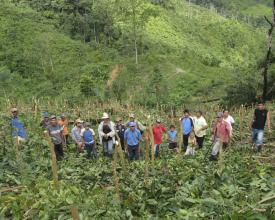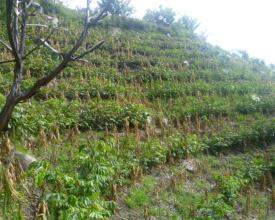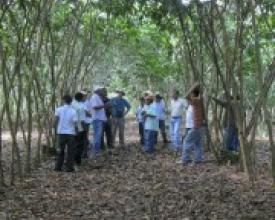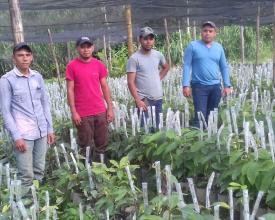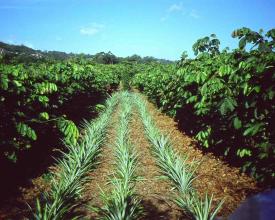
Land For Life: Organic, Regenerative Agroforestry for 100% Food Security with the Inga Tree Model
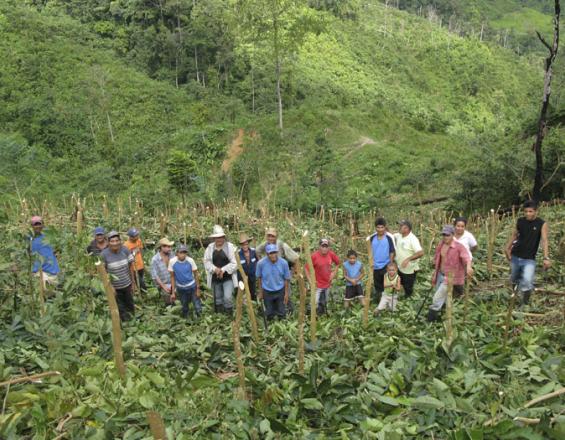
Since 2012, the Inga Foundation’s simple agroforestry system of Inga Alley Cropping has empowered 300+ families who have planted over 4 million trees dramatically transforming their lives.The ability of the resilient Inga tree to anchor, enrich, and regenerate depleted soil provides food security with 100% success for families with 2 year-old alleys. These fast-growing native Inga species which fix nitrogen in the soil provide organic cash crops as well as significantly reduce global carbon emissions, protect wildlife and marine habitats, preserve water sources and yield a year’s worth of firewood. The basic grains/cash crops are grown without herbicides, pesticides, chemical fertilizers, or heavy equipment. Inga seedlings are planted in rows on steep, degraded slopes and require no technology or heavy equipment. The Model positively addressing 11 of the 17 United Nations SDGs with NO NEGATIVE IMPACT whatsoever on the remaining 6.
Context
Challenges addressed
FINANCIAL-Nature-based solutions face the reality that less than 3% of public investors support agroecology.
WEATHER-The Inga alleys have survived back-to-back hurricanes with no damage, 8 inches of rain falling in 18 hours, and 7 months of drought. The trees and thick mulch stop all erosion and mudslides and several dozen springs have appeared in established alleys.
COVID-19-Training is entirely outdoors with an entire family participating so the foresters/field technicians are able to wear masks and train/plant seedlings with the family at their plot. With military lockdown, we are fortunate there is only a delay in training new families at the farm.
Location
Process
Summary of the process
The Wikipedia entry on Land Degradation says:
"It is estimated that up to 40% of the world's agricultural land is seriously degraded."
Small-scale farmers in developing countries are already bearing the brunt of the climate crisis, yet they have received little of the promised funding to help them adapt to degraded land, drought, flooding, and heat.
Now in year 10, the resilient Inga Tree Model, with its integrated benefits, fulfills the primary needs of subsistence farmers by providing sustainable agriculture with no barriers. No group has ever been turned down to receive instruction. The grassroots program provides training and planting assistance as an alternative to slash-and-burn without debt, and families who see the program are eager to participate, learn from each other, and pay it forward--giving farmers the power to regenerate historically degraded soil on long-deforested hillslopes with a multiplier effect, spreading agroecology knowledge and experiences with full participation for women and young people.
Building Blocks
Bottom-Up as successful strategy
The families are 100% in charge of their land--making all the decisions about what they wish to plant and adding other components from our nurseries (citrus, hardwoods, cash crop alley for turmeric, black pepper, pineapple, avocado, Allspice, cacao, vanilla, ). The Inga Tree Model program has over 200 families waiting to plant alleys. They have seen the results of their relatives and neighbors and many have visited the demo farm to see for themselves how planting trees secures their futures.
The all-Honduran team live in the two river valleys, are farmers themelves, who are known, trusted, and respected in the communities. The families have no debt or loans and are independent after their first pruning in 18-24 months. Not a single family that has adopted the model has reverted to slash-and-burn.
Families “pay it forward” by raising Inga seed stock and helping others with planting. This farmer-to-farmer initiative ensures the natural expansion and lasting success of the system. Inga alley cropping underpins the values needed for meaningful change in the global south.
Enabling factors
The most important enabling factor is trust. We achieved that by always doing what we said we would do. Neither Covid-19, hurricanes or droughts have negatively affected the program. Families share their native seed and cooperate to make efficient use of their time. They save 30-40 days of weeding as the trees shade out all weeds. Firewood from the annual pruning is done with machetes and is a valuable resource that is shared/sold/traded by the families themselves. The demo farm has served as a drop-off and collection point for group drying/sales of peppercorns.
Lesson learned
The all-Honduran team understood the importace of flexibility on many occasions when flooding or COVID-19 caused plans to change--always having a back-up (mules for seeds distribution or contracting a Caterpillar to clear roads after the twin hurricanes in Nov. 2020). They delivered food and water and transported several dozen villagers to medical facilities.
The Honduran team is the most experienced in the world and has taught all others who are installing Inga alleys. We have facilitated Inga alley replication in 15 countries with farmer/NGO/government groups by providing training at no cost to over 60 groups and providing native seed to many. They know the significance of what they are accomplishing and take great pride in their work. The nursery staff plants the crops that families request.
The program exceeds all expectations because the families are in charge--with tremendous co-operation among them-- like pruning in exchange for firewood, offering complementary skills, and working together spontaneously. They are listened to, respected, and valued.
Low Inputs meet smallholders where they are
Community-based innovation/local knowledge combined with science-based approaches are the best way to address problems of the rural poor. Smallholders in the tropics who have depended on slash and burn agriculture for generations want new ways to improve their lives-without crippling debt. Most all technology inputs in the global south require extensive infrastructure as most rural regions do not even have digital capablity or even cell phone service and families could not afford them even if they were available.
The simple planting techniques on Inga Alley Cropping combined with the amazing resilience of the Inga species show a clear and scalable path for saving rainforests and their rich biodiversity while providing 100% food security.
Enabling factors
Inga Alley Cropping creates economic incentives that regenerate steep, degraded land without debt or loans for farmers.
Families no longer purchase agrochemicals which were necessasy when they used slash and burn, nor is any heavy equipment, machinery, or chemical fertilizer needed.
Inga Alley Cropping respects the traditional skills and innovations of the people closest to the land who through their land, labor, and care have demonstrated, at landscape-scale, how the Inga Tree Model can be replicated across entire landscapes.
.
Lesson learned
According to the World Bank, “Over the past decades, agricultural policy and international institutions, as well as private and public agricultural research have often considered small-scale/subsistence farmers as backward “phase-out models” of a pre-industrial form of production.”
The strength of the Inga Model--is that it addresses the root of the problem, and even in this region experiencing the worst climate shocks, provides what farming families need most--100% food security within 1 ½ years.Families are not getting subsidies, they are getting seeds, training, and assistance with their planting/ first pruning. After that, they are independent with the skills to add a cash crop alley. Their choices bring about the change--from family, to community, to a nation that can all face an uncertain future with resilience and true sustainability.
Impacts
Inga Alley Cropping- model of sustainable best practice in rural livelihoods
- Environmental--stopping slash-and-burn agriculture in the humid tropics (practiced by 200 million smallholders) with a proven alternative (Inga Alley Cropping) which promotes local practices, native seed, organic food sources, and knowledge while adapting to climate crisis conditions; sequestering and avoiding massive amounts ofCO2; regenerating steep, highly degraded land; stopping all erosion and mudslides, eliminating all agrochemical inputs; watershed protection; The Inga tree alleys were unscathed from the Nov. 2020 back-to-back hurricanes with no damage at all to the 300+ tree alllleys and farmers were able to plant on schedule
- Social-100% food security for farmers; annual, renewable firewood so forest trees are not cut, protect habitats and increase biodiversity; livelihood improvement from sale of cash crops. Large savings on labor for weed control (reported by farmers to save 60 days/year). The family is trained together and work close to home. Families are not forced to become climate refugees
- Economic-livelihood improvement from sale of cash crops; farmers have no debt, loans or microloans; firewood produced from annual pruning may be sold or traded.
Beneficiaries
Rural, subsistence farming families achieve true sustainability-eliminating their dependence on slash-and-burn and they are not forced to become climate refugees.
Sustainable Development Goals
Story

When he could find work-- Damas Nunez could earn $2 a day. He reached a point of desperation and decided his only option was to flee north as an undocumented worker. But a visit to a friend in the Cuero Valley who had implemented Inga Alley Cropping astounded Dumas, who subsequently received training/seeds from Inga’s team, showing him how to regenerate his degraded plot. Damas now has food security for his family and cash crops to sell.
The cycle of poverty/food security & increasing climate shocks force continued slash and burn agriculture and there is no technology/infrastructure for most remote smallholders. But low-cost, regenerative agroforestry with Inga alleys provides options, opportunities,& promotes land stewardship- true and sustainable "Land For Life."

